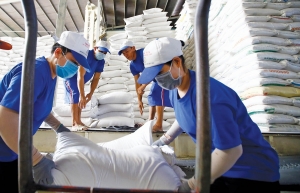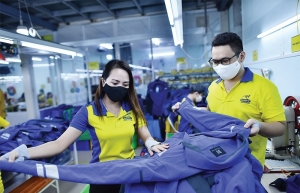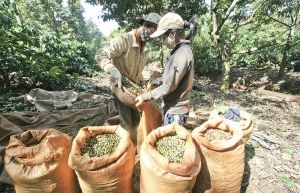Amplifying EVFTA’s origin compliance
Nearly three years into implementation, relations have undergone a gradual growth in trade turnover. According to the General Department of Vietnam Customs, the bilateral trade turnover recorded $61.3 billion in 2022, up 7.69 per cent in comparison with the previous year; of which Vietnam’s export took up $46.7 billion, up 15 per cent, and import worth $15.26 billion, down 9.65 per cent on-year.
 |
| Nguyen Huu Nam, Technical assistance expert ARISE+ Programme Vietnam |
One great influence that EVFTA has brought to Vietnamese businesses is the increasing portion of taking advantage of tariff incentives. According to the Ministry of Industry and Trade’s statistics, the value of exported merchandises using the EUR.1 Form in 2021 reached approximately $8.1 billion, accounting for roughly one-fifth of the export turnover with the EU. In the first 10 months of 2022, the rate increased to 25.1 per cent, up 30 per cent on-year.
The potential for Vietnam’s export to the EU is huge, as the EVFTA has created plenty of rooms for Vietnamese businesses to further make good use of tariff incentives. Along with its positive impacts, the new-generation trade pact also poses many hurdles for domestic companies. One of them is the strict compliance with rules of origin (ROO), especially in those industries which Vietnam’s economy has not still had its competitive advantage in the supply chain of raw materials.
ROO is considered as one of key factors to enjoy the preferential tariffs and bring Vietnamese products into the EU market. In fact, many of Vietnam’s export items to the EU have not overcome technical barriers, in addition to stringent requirements on sanitary and food safety. This is because of Vietnam’s limited capacity for controlling and supplying input products for manufacturing industries.
The EVFTA was put in place to bring real benefits for the Vietnamese economy. However, for electronic products which reach a dominant value in Vietnam’s export revenue, the localisation rate of this group remains extremely low. At present, most of the exported electronics are assembled based on components imported from China, South Korea, and Taiwan.
Textiles and apparel, other key export items, are facing the same issue as the supporting industry for the category is still undeveloped. This has therefore hindered local manufacturers to reap benefits from the EVFTA. To make better use of the trade pact, Vietnamese producers must move up to higher in the global production chain. This approach enables domestic companies to enjoy great benefits and better fulfil the strict requirements related to ROO ratified in the EVFTA.
Apart from that, aquatic products are one of the categories which can tap the full potential of tariff incentives. Seafood is also one of Vietnam’s major export items, recording a high value of trade turnover with many countries around the world. These products are principally manufactured with input materials originated from Vietnam, and thus, they can satisfy ROO-related requirements.
Compliance with the ROO is only part of a bigger challenge, which is to uplift the Vietnamese economy to a higher level of sustainable development. Aside from the role of helping Vietnamese firms deliver their products to the EU, ROO can be served as a useful instrument for assessing Vietnam’s limited capacity for manufacturing components and basic main parts.
The more we know about the low utilisation of ROO in the EVFTA, the better we understand about how to solve the problem, and the low utilisation rate unveils a critical issue of the Vietnamese economy. The lack of supporting industries has created a bottleneck for Vietnamese-made goods to access to the EU and hinders local exporters in making good use of the agreement.
These hurdles can be surmounted if the Vietnamese government and local businesses work together to put in place far-reaching reforms in the regulatory framework and production.
On the one hand, for the private sector, the government should adopt policies to attract more domestic and foreign investment in supporting industries. For electronics, there is a need for an effective mechanism to lure more investors into the manufacturing of key components and parts with high value in technology.
For garments and textiles, local authorities should be aware of the significance of investment attraction in the textile dyeing industry. And for aquatic products, state agencies and associations should formulate supporting policies to raise awareness of the conformity with technical standards and regulations imposed by the Vietnamese government, and especially from the EU.
On the other hand, for the private sector, Vietnamese businesses should increase capital in the supporting industries, especially those with a high value of trade turnover. For electronics, domestic companies are advised to pay more attention to technological factors with an aim to manufacture quality components and parts with diverse designs at a competitive price.
Seafood processing and exporting businesses are also required to have a comprehensive understanding of requirements and customers’ taste applied in the destination countries. They can therefore disseminate accurate and up-to-date information to the relevant stakeholders.
 | Vietnamese EU exports benefit from trade deal Vietnamese exports to the EU in 2022 are expected to touch nearly $48 billion thanks to the strong driving force of the EU-Vietnam Free Trade Agreement (EVFTA). |
 | Maximising the benefits of EVFTA Entered into force in the context of the bilateral development of relations, the EU–Vietnam Free Trade Agreement has brought both positive impacts in many fields. Peter Bernhardt, Dr. Eduardo Austin and Prof. Dr. Konstantinos Athanasiadis of the ARISE+ Vietnam Project explain how Vietnam can face up to the challenges that the country’s private and public sector need to address in the years to come. |
 | The significance of Vietnam for US businesses and why they should take notice Vietnam has gone from being a frontier economy in ASEAN to a flourishing, cost-effective, and industrial nation. Firms and investors that are looking for new markets to grow, source, or manufacture their products – especially in Asia – should consider Vietnam’s long-term potential and stay updated on its opportunities. |
 | Rules paradox hinders plans for EU exports Though the EU-Vietnam Free Trade Agreement will remove import tariffs for many export items into the EU, costs for access to this market are set to increase in addition to strict rules of origin, making it difficult for exporters to benefit from the deal’s advantages. |
What the stars mean:
★ Poor ★ ★ Promising ★★★ Good ★★★★ Very good ★★★★★ Exceptional
 Tag:
Tag:
Related Contents
Latest News
More News
- Main drivers for Vietnam’s digital economy future (December 03, 2025 | 11:35)
- Pivotal stage of growth paves way for rise in M&As (December 03, 2025 | 10:00)
- Positive projections for M&A interest from Thailand (December 03, 2025 | 09:40)
- Manifesting the first line of defence in cybersecurity (December 03, 2025 | 09:00)
- The transformational role AI can play in accounting arena (December 03, 2025 | 08:00)
- Unlocking 5G-AI potential in Singapore (December 03, 2025 | 08:00)
- Data-driven strategies vital for a fast-evolving nation (December 02, 2025 | 09:41)
- Policy to practice: how Vietnam can lead the region (November 26, 2025 | 16:03)
- Mobilising private capital at scale vital for climate battle (November 26, 2025 | 15:36)
- VILAF and Yoon & Yang launch Vietnam - Korea Practice Unit (November 26, 2025 | 15:16)




















 Mobile Version
Mobile Version